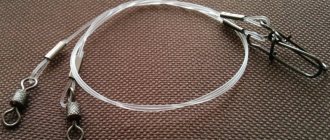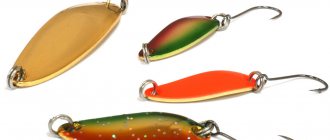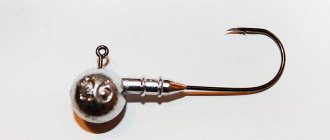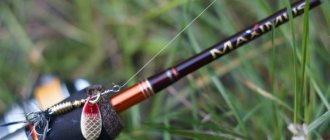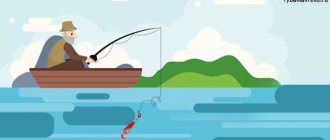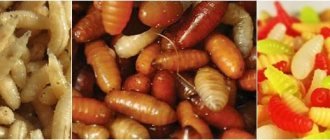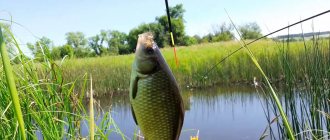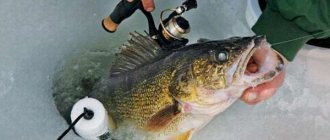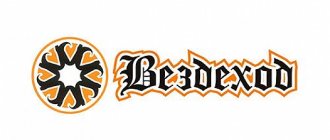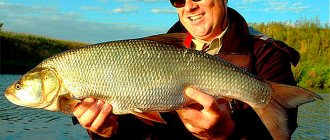A retractable leash or Moscow rig is used for catching perch, pike perch, catfish, pike or asp. Sometimes peaceful fish are caught on such equipment. Fishing takes place in the bottom layers of water. The main purpose of this rig is to separate the bait from the sinker. This method allows you to catch even the most cautious fish.
A retractable leader is a rig in which the weight is at the end of the line, and the bait with the hook is slightly higher and to the side. Thanks to this arrangement, predatory bottom fish are caught on the hook. There is also another name for this design - Carolina.
Advantages:
- There are several installation options;
- allows for long casts;
- lack of windage;
- high sensitivity during wiring;
- the bait looks and moves naturally in the water;
- the use of equipment allows you to fish a large area.
Flaws:
- installation is very complicated and requires a lot of time;
- the wiring speed is not very high, which is not always good when catching active predators;
- if you make a mistake during installation, or place the bait incorrectly, there will be no catch;
- successful fishing depends on dexterity and skills, especially at different current speeds;
- if the bottom is muddy, then fishing with such equipment is impossible - the weight will sink in the viscous soil;
- if the bottom is rocky or there are a lot of underwater plants, then false bite signals occur.
Types of installation of branch leads
Let's take a closer look at the main types of installation of diverter leashes for catching predators.
Solid installation
The blind method of installing a branch lead is considered the simplest. The weight is attached to the end of the main line, and a loop is formed at a height of 30 cm from the weight. It is to this that the leash is attached, to which the hook is attached. You can also add a windbreaker to the loop for spinning baits, which will improve their behavior in the water.
Sliding option
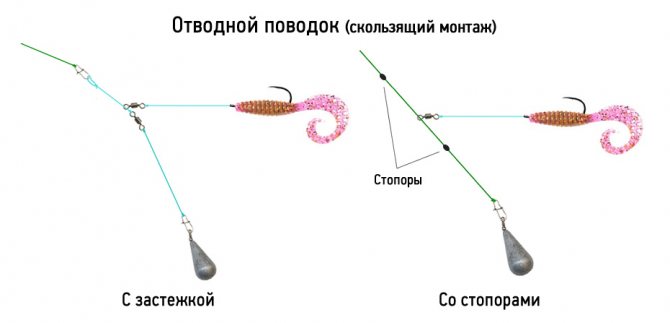
A fastener is attached to the end of the main cord, to which a leash about 30 cm long is tied, to the end of which another swivel with a weight is added, and between this swivel and the fastener a sliding swivel with a leash and bait is put on.
There is also an option for sliding installation of the outlet leash using stoppers. A swivel is installed on the main cord, which is fixed at the top and bottom with rubber stoppers and a weight is tied to the end. For the sliding version, a leash with a length of 20 to 30 cm is used.
On the clasp
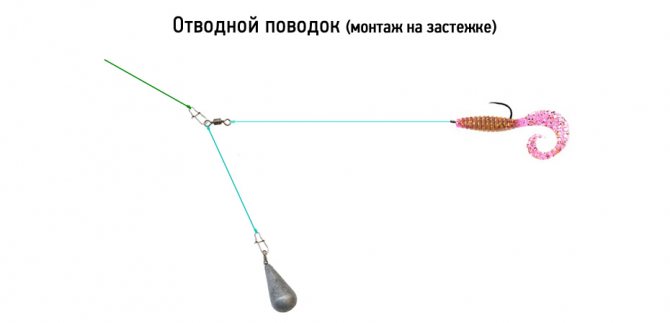
On a clasp - a method that is more difficult to implement, but much more convenient to use. A fastener is attached to the end of the main line. A sinker is attached to one end of the leash, and a swivel to the other. It is to this swivel that a small piece of fishing line is attached. It is secured to the clasp with a regular loop. A bait leash is attached to this section of the loop using a swivel.
Thanks to this trick, the retractable leash can slide freely and does not overlap with the main line. Thus, it is possible to avoid tangling of the fishing line. The leash on which the hook is located can be easily replaced. Just unfasten the clasp, remove the old one, and put on the new one.
With triple swivel
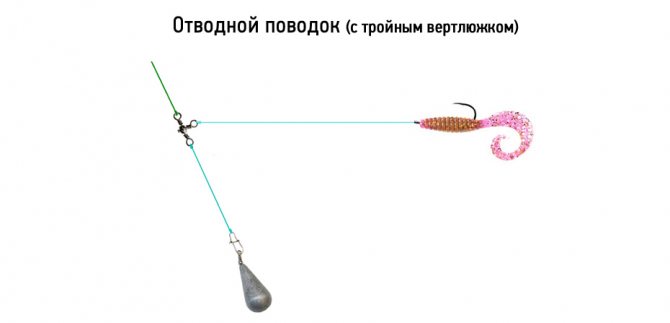
A triple swivel is tied to the end of the braid. The Palomar knot is used for this purpose. A piece of braiding 30 to 40 cm long is tied to one of the edges using Palomar or Clinch knots. A load is placed on the other edge.
A retractable leash made of monofilament fishing line from 30 to 150 cm is attached to the swivel ring, which is located away from the other two, and the hook is secured using a Clinch knot.
How to make a leash for a pike with your own hands
It is not difficult to make a leash for a pike with your own hands. For this work, you will need to purchase the material from which the product will be prepared, as well as additional elements for equipping the leashes. The list of additional elements includes: swivels, carabiners or clasps, winding rings and metal tubes of small diameters, which are used for crimping connections. The tools you need to carry out the work include pliers, a sharp knife, scissors, wire cutters and, if possible, an electric screwdriver. In the next part of the article, we will look at the technology for manufacturing driving elements from the most common materials, which can be purchased at a low cost in specialized retail chains.
Special leader material

In a fishing store, you can purchase leader material, which is sold in rolls in 1-3 meter sections. Blanks are cut from a long piece of twist, the length of which is calculated based on the working size of the leash and the dimensions required to create two fastening loops at the ends of the product. To form one loop, allow 30 mm.
Important! The loops will be clamped with a crimp tube, the diameter of which must correspond to two diameters of the leading material.
The tube is put on the end of the cut, followed by stringing a swivel onto the workpiece, which will later be used to tie the leash to the fishing line. The remaining tip of the cut is bent and inserted into the tube, bringing out the tip of the material 2–3 mm long from its other side. Now all that remains is to use pliers to crimp the tube in two or three places, making pressure in different planes relative to one another. On the reverse side, exactly the same operation is carried out with the only difference being that instead of a swivel, a clasp is used to wind it into a loop. These simple operations allow you to obtain a plastic and reliable accessory of the size required for fishing conditions.
Steel leash
A steel leash for pike fishing can be made from thin wire, or guitar strings 1 and 2 are ideal for these purposes. The required piece of material is cut off with wire cutters, first taking into account the margin for forming the loop required at both ends of the product. For steel, allowance for hinges is 20–25 mm. Next, bend the tip of the wire into a loop. The radius of the loop should not be less than 3 mm, otherwise the small distance will affect the performance of the fastening and auxiliary element strung on the steel.
A fastener or swivel is inserted into the loop blank, after which a turn is made with the free end around the main wire using round nose pliers. Next, an electric screwdriver will help ease the twisting and make the connection tighter. Having hooked the loop with a hook inserted into the screwdriver chuck, the piece of wire clamped in a vice is twisted until the turns of the free end are completely laid around the base. The same operation is carried out with the second end of the workpiece, inserting the desired auxiliary element into the loop. The lengths of the steel product vary in the range from 10 to 30 cm.
Fluorocarbon
You can make a fluorocarbon leash for a pike using the method of making an accessory from a leash material. For manufacturing, take a piece of fluorocarbon with a thickness of 0.35 to 0.50 mm and select a crimp tube with a diameter double that of the fishing line. The length of the tube itself must be at least 10 cm.
Important! Since fluorocarbon line for pike leashes is much softer than steel leash material, the crimping operation is done especially carefully, paying attention to the crimping force.
The clamp is guaranteed to make an undercut on the fishing line, which will significantly weaken its breaking load. A fluorocarbon product for pike fishing can be prepared in absolutely any size.
Lures for diverting leash
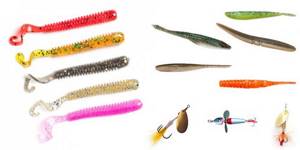
There are edible and conditionally edible baits for the withdrawal leash. At the moment of a bite, the predator will not spit out such bait, but will try to swallow it. Thanks to this trick, the fisherman will have more time to hook.
To catch predators on a retractable leash, imitation invertebrates, such as crayfish, beetles, and worms, are most often used. Twister, vibrotail and foam fish are also used. Sometimes a jig bait is used, but it must be highly sensitive and selected according to weather conditions.
It is also permissible to use a spinner that can rotate, or live bait.
Lures with bright colors are used only in muddy water. If the water is clean and clear, then too bright a color will scare away the fish. The main quality of the bait is naturalness.
How to choose a leader material for pike: tips
The choice of flood directly depends on weather conditions and the fish that you plan to hunt. Pike is a large predator that has large teeth, and also sharp ones. You should choose the strongest leash for it to avoid breakdown.
In addition, the flood must meet the requirements:
- The material should not weigh down the fishing rod so as not to affect the nature of fishing.
- Inconspicuous - so that the pike does not see it.
Let's celebrate! In some situations, strong and thin have completely opposite meanings, so the fisherman’s task is to find something in between.
Accessory for diverting leash
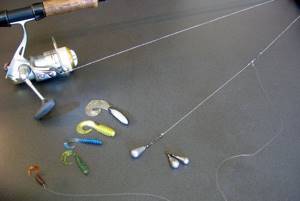
Let's take a closer look at what equipment is used for the outlet leash.
Form
For the retraction leash, a light spinning rod with high sensitivity and fast action is used.
If you plan to fish from the shore, then the length of the gear should be up to 2.7 m, and from a boat - up to 2.5 m.
Line selection
Instead of the main monofilament, you can use a braided cord. Regular braided fishing line is also used. To reduce resistance with water in strong currents, use a small-diameter braid that is sensitive to any bites.
If the bottom is rocky or there is a lot of shell rock, then fluorocarbon (from 0.26 to 0.35 mm) or monofilament is most often used.
For the leash, monofilament or metal cable is used. This material has a lower breaking load. The diameter of the leash can be from 0.16 mm to 0.2 mm.
The length of the leash for a weight is 20-30 cm, and for a leash with a hook from 50 to 150 cm. Braid is not used here, since it is prone to tangling.
Sinker

The weight and appearance of the cargo depends on the characteristics of the reservoir and fishing conditions.
When choosing, the following factors are taken into account:
- wiring speed and current power;
- depth of the reservoir;
- casting distance.
On average, a load can weigh from 5 to 25 g, but if the current is very strong, then heavier weights are selected. The shape can be very different. ordinary weights have the longest range, but they can only be used if the bottom is clean, without snags and stones.
The Tyrolean stick or banana-shaped weight has good maneuverability in difficult areas, but it raises a cloud of silt upon impact and also has poor range.
The most commonly used weights are pear-shaped. For a retractable leash, this is a universal option.
Hook
If the bottom is clean, you can use a hook with a long shank. If the bottom is overgrown with grass, then offset hooks are used. Their size depends on the intended prey and the size of the bait.
Leash
For a sinker, a leash with a length of 20-30 cm is used. For a leash with a hook, it is from 50 to 150 cm. The thickness of the leash can be from 0.16 to 0.2 mm. It depends on the type of fish and the characteristics of the reservoir.
For the leash, monofilament or metal cables are used.
Criterias of choice
Of course, there are no trifles in fishing. The leash and bait play one of the most important roles here. Choosing them incorrectly can greatly affect the result. So, what circumstances should be taken into account when choosing it?
First of all, let’s decide in what cases is it needed and in what cases is it not? It is generally used for two reasons.
If you are going to catch pike, then you can quite expect that it will gnaw through the fishing line. Even if you use other types (for example, wicker), the result will be the same.
Only a wire leash can save the situation. In any other case, the bait will be lost. Another reason for using it is that when using different baits, it may be convenient to prepare several options in advance, and when fishing, only connect them to the main part of the fishing line.
If you need a leash, then choose it based on your specific situation. Let's consider this issue in more detail.
Fishing conditions
If you are fishing from the shore, which is overgrown with reeds, then casting a spinning rod far will be problematic if both the rod and the leash itself are too large. In addition, an important role in choosing it is played by whether the fishing will take place from a boat, or whether the spinning rod will be cast from the shore.
The nature of the bottom surface and water transparency also influence its choice. For example, for catching pike it is customary to use steel tackle due to the fact that the pike cannot gnaw through it. However, such a choice may lead to the fact that she will be able to see him and the bite will not occur.
Some fishermen consider it justified in such cases to use a more transparent and inconspicuous leash using some inexpensive bait. In this case, there will be a greater chance that the fish will bite and not fall off the hook (even if the bait disappears several times).
Character of the fish
As you know, the behavior of each species of fish has its own characteristics. For example, if you catch pike, you must take into account that this predator has sharp teeth. If the main property is its invisibility, and not strength, then it is more profitable to use a fluorocarbon leader rather than a steel one. Of course, if it exceeds a certain thickness, it becomes noticeable to the fish, and if it is thin enough, then it performs its function perfectly.
Fishing style
Almost everything is important in fishing. We are talking not only about the characteristics of a particular type of fish. Many other factors also matter.
- Time of day.
- Illumination.
- Water transparency.
- The nature of the bottom surface.
- Bottom color.
- Wind strength and direction.
- Food supply for fish at the fishing site.
- Dimensions of the fishing item.
- The degree of its activity.
- And also other factors.
Depending on the specific situation and on the knowledge, experience and luck of the fisherman, its various properties may come to the fore when choosing a leash. Sometimes we are talking about strength, sometimes about softness (so that the game of the bait is not disturbed), sometimes about transparency (so that the fish cannot detect it) or about its other features.
How to tie a diverter leash

There are different ways to tie a diverter leash. This is a surgical knot, Palomar, snake, running, fisherman, loop to loop.
Loop to loop.
It is used to connect fishing lines of different types. To do this, fold the end of the fishing line in half, use the end of this loop to make several turns around the base and pull the loop through the turn that was formed first.
Such loops are made at both ends that need to be connected. After this, the loop of the leash is thrown over the main one, and then the second end of the leash is threaded through it and the knot is tightened.
Fisherman's knot.
Two fishing lines are placed parallel. The lead end needs to be wrapped around the main line and pulled up. Pull the end of the fishing line through the loop that has formed. After this, pull the end of the wire through the loop again. Tighten the resulting knot.
Repeat all steps with the main fishing line.
How to fish with a retractable leash
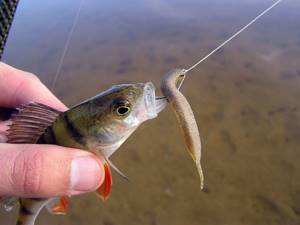
Let's take a closer look at the methods of fishing with a retractable leash.
Features of fishing on the river
Most often, a sliding mounting option is used for such fishing.
If casting against the current is used, then the fisherman follows the current. The sinker should move slightly above the bottom so that the flow of water independently carries the equipment. When casting downstream, twitching and pulling are performed. Thanks to this tactic, the bait plays and resembles a living object.
Fishing in a lake or reservoir
In standing water, blind and sliding installation options are used. The cast is made towards a more promising place. Without movement, the water will only play bait thanks to the spinning rod. He should twitch or wiggle with the rod tip.
A universal technique for fishing with a retractable leash is 2 short jerks while turning the reel, followed by a pause of 2-4 seconds. If the fish is passive, then the pause can last 10 s. A similar tactic works on perch, pike and pike perch.
Types of postings
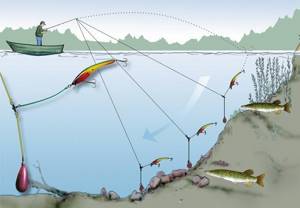
Let's study the types of wiring in more detail.
Soft wiring
A smooth pull-up is performed with the tackle, as a result of which the bait should move along the bottom of the reservoir at a very slow speed. At this time, the fisherman makes careful twitches with the tip of the rod. Braids are used for this technique. They straighten out very quickly if you lightly tighten the line with a reel. This technique is most suitable for catching perch.
Sharp wiring
Using the tip of the spinning rod, sharp jerks or swings are made. Thus, the bait rushes forward, and the line does not sag. This technique involves using long pauses. For such cases, an eight-strand braid is used.
Dragging along the bottom
The bait is thrown into a promising place and slowly pulled up by winding the reel onto the fishing line to the place where the fisherman is located. It is very important that the bait touches the bottom and does not rise up. This technique is used in places where there is a rip current, there is snags or there are a lot of shells at the bottom.
For fishing, the spinning rod is placed vertically, but is not wound behind the back. At the same time, the fish is pulled towards you. After this, the spinning rod returns to a horizontal position, and the fishing line is wound onto the reel. After this, all actions are repeated.
Fluorocarbon
A relatively recent invention. Appeared in 1971 in Japan. Artificial polymer. Its advantages include the following:
- Resistant to aggressive environments, including physical ones.
- Does not change its properties in severe frost and extreme heat.
- UV resistant.
- They do not get wet or swell in water.
- Heavier than a regular leash or nylon leash.
- Softer, which makes the bait play more attractive and natural.
The disadvantages of fluorocarbon include:
- Less abrasion resistance.
- Less resistance to the teeth of predatory fish.
- Less breaking load.
- The cost of fluorocarbon fishing line is high, since the production cost is higher than nylon fishing line.
Suitable for fly fishing, pike perch, perch or for use when fishing for non-predatory fish. This material is not suitable for using fluorocarbon when fishing for pike or when fishing in a reservoir with a rocky and snagged bottom.
Separately, it is worth mentioning that recently a whole series of nylon fishing lines coated with flucocarbon has appeared on sale, which gives the fishing line the properties of this material. Such fishing lines are cheaper than a product made entirely of fluorocarbon.
Where to fish with a retractable leash
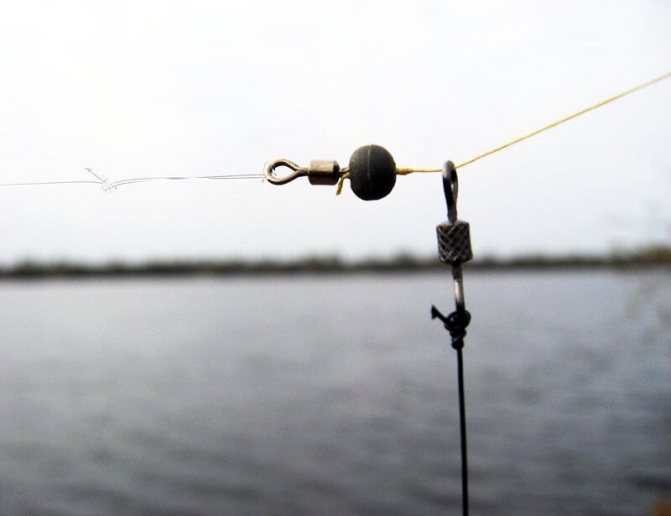
Fishing with a diverting leash can be carried out both in still water and in the current.
Most often this method is used to catch predators. They prefer to hide in the depths, at the exits of holes, in places with dense underwater vegetation or in snags. There is also a chance to catch a pike or pike perch where a tree has fallen into the water.
Fishing with a diverting leash is carried out in places such as: on rivers, lakes, reservoirs in places with great depth.
{banner_vnutri-kontenta-3}
Do you need a leash?
There is no consensus among fishermen. Some people think that such gear only scares away river predators, and in case of a break it does not retain the bait anyway. Others, on the contrary, claim that the leash even gives the bait additional mobility.
Much depends on the material from which the leash is made. The stronger, the more reliable, but also the more noticeable the tackle itself.
Apparently, like any gear, a pike leash has and will have its fans and opponents. But you still need to know its advantages.
Retractable leash for perch
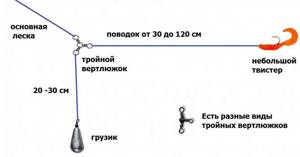
For perch fishing, choose a long rod. Its size should be from 2.4 m to 2.7 m. If you plan to fish from a boat, 2-2.4 m is enough. Longer forms reduce sensitivity.
For catching perch on a retractable leash, medium-fast or fast action forms with a test weight of 5 to 25 g are suitable. Four-strand braid with a thickness of 0.12 to 0.16 mm is also used. For wiring, use fluorocarbon fishing line with a diameter of 0.2 to 0.24 mm.
A twister 2 to 3 cm long is used as bait. Even with passive play, a predator will notice the bait due to its bright color. Worms, creatures and slugs are also suitable. You can use a vibrating tail, but then you need to put a small weight on the hook. This will make the game better. It is also possible to use a wobbler and a spinner that rotates.
If the weather is clear, then you can hook a bait of natural colors, but in cloudy weather visibility is poor, and the bait should be brightly colored.
When fishing for perch, you should not make a sharp hook. This fish has a very delicate lip and it can tear. This feature should also be taken into account when fishing - too much haste or a sharp jerk often leads to loss of catch.
In summer, perch is caught in areas with snags and vegetation. This fish also hunts on edges or in deep areas.
In cold weather, perch hides in the depths. It can be waylaid at the exit of a pit or on a deep riffle.
The bite signal can be very different. The predator can gently pull or make a sharp jerk. The rattling of the bait can also be a sign of a bite.
Retractable leash for pike perch
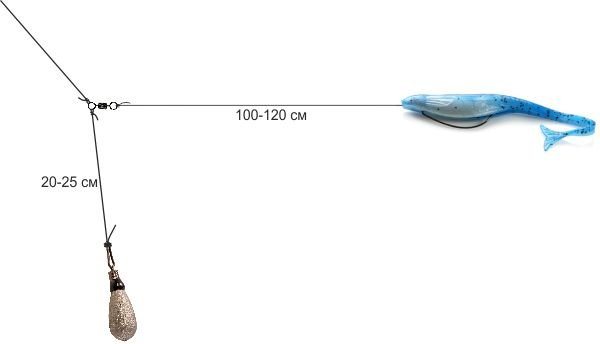
To catch pike perch on a retractable leash, use a fast or ultra-fast action form with a weight of 7 to 25 g. This will allow you to cast as far as possible, quickly and firmly hook, and also control the silicone bait. The allowed length is 2-2.4 m when fishing from a boat and 2.4-2.7 when fishing from the shore.
You can use a multiplier reel, which will allow you to quickly and efficiently lay the fishing line. The presence of a friction clutch is also important.
For the main line, take braid with a diameter of 0.16 mm to 0.2 mm. For wiring, monofilament (0.21-0.24 mm) or fluorocarbon (0.26-0.35) is suitable. The last option is used if there is a possibility of catching pike.
Twisters with a length of 5 to 7 cm are used as bait. If the pike perch is passive, then you can take small baits. You can also use longworms, slugs and creatures.
You can use a wobbler that hangs in the water column, a rotating spoon or a suspender.
Pike perch is most often found in flooded snags, or near trees fallen into a pond. The predator can also be found at the exit from a pit, near a hydraulic structure, or in places where there are uneven areas or changes in terrain.
If the river is small, then it is worth remembering that pike perch prefers depth. Such places can be found under a steep bank.
When biting, you can feel the heaviness when winding up the fishing line or a clear blow to the rod. At the same moment it is necessary to make a quick and sharp hook. The pike perch's mouth is very hard, and at the moment of hooking the hook must pierce it.
Materials, their advantages and disadvantages
Fluorocarbon

Pros:
- Invisible in water.
- Soft.
- Free from “memory effect”.
- Optimal buoyancy.
Minuses:
- Low strength.
This material looks like fishing line. Fluorocarbon leaders do not perform well when fishing for pike. The fish simply snacks on them. It makes sense to use it when the predator is most cautious.
Leading material

It is a steel cable covered with plastic or lavsan insulation.
Pros:
- Low price.
- High strength.
- Correctly selected coating color provides reliable camouflage.
Minuses:
- As a rule, ready-made wiring made from this material is equipped with cheap fittings: the fasteners quickly rust and break, unfastening spontaneously, which leads to the fish leaving after a bite.
- Heavy , and, as a result, spoil the game of the bait.
- Has memory.
- They become “shaggy” after being in a pike’s mouth.
Due to its heaviness and rigidity, it is suitable for heavy spinners and wobblers (if you are a spinning fisher) and large live bait (if you prefer natural baits). Even a very large predator cannot bite through the wiring material.
Guide material without coating
Pros:
- Cheap.
- Lasting.
- Clearly visible in water;
Minuses:
- Fasteners quickly rust and break.
- Heavy.
- It has a strong memory - after a bite it bends so much that you can throw it away.
- Not suitable for cautious fish . During periods of intense biting it can help out.
Guitar string leash
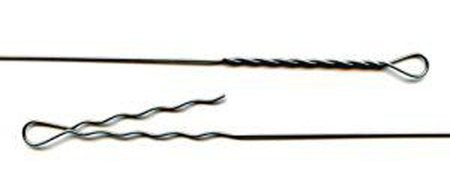
Pros:
- Cheapness .
- Lightness (the influence on the movement of the spoon/wobbler in the water is minimized).
- Optimal material for self-production.
- Elasticity.
- Reliability.
Minuses:
- Visible in water.
- Finished products from store shelves are equipped with cheap fittings.
Lots of benefits for little money. The best option for those who do not waste money. Indispensable for those who love to tinker and experiment.
Titanium
Pros:
- B high tensile strength.
- Not subject to deformation.
- They became at least 2 times lighter.
- Has no memory.
- Does not introduce significant distortions into the operation of the bait.
Minuses:
- Poor disguise.
- Expensive.
The material is quite new and not widely used. Titanium leashes are strong and durable, just right for large pike. A significant disadvantage is the price. It is advisable to use with expensive baits and in cases where a break is, if not excluded, then unlikely. For jig fishing with budget silicone baits, use something simpler.
Tungsten
Pros:
- M softness, which does not spoil the wiring of the wobbler/spoon.
- Strength.
- Low cost.
Minuses:
- Easily deformed.
Soft material. When they catch at least some significant trophy, they turn into something incomprehensible. It is recommended to constantly check the integrity. Low cost allows use as a disposable option.
Kevlar leashes have the advantages of metal ones, but with greater lightness and less rigidity.

